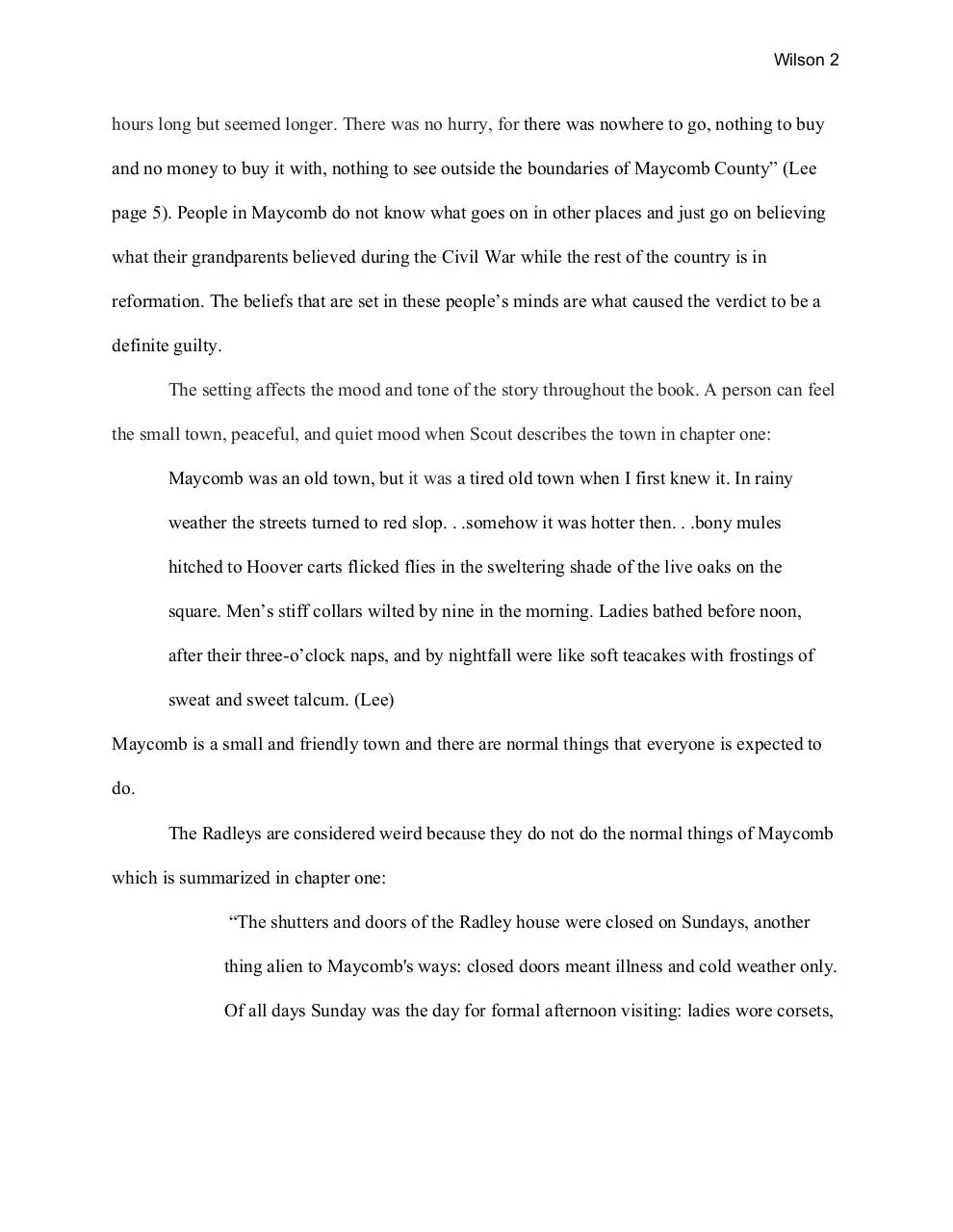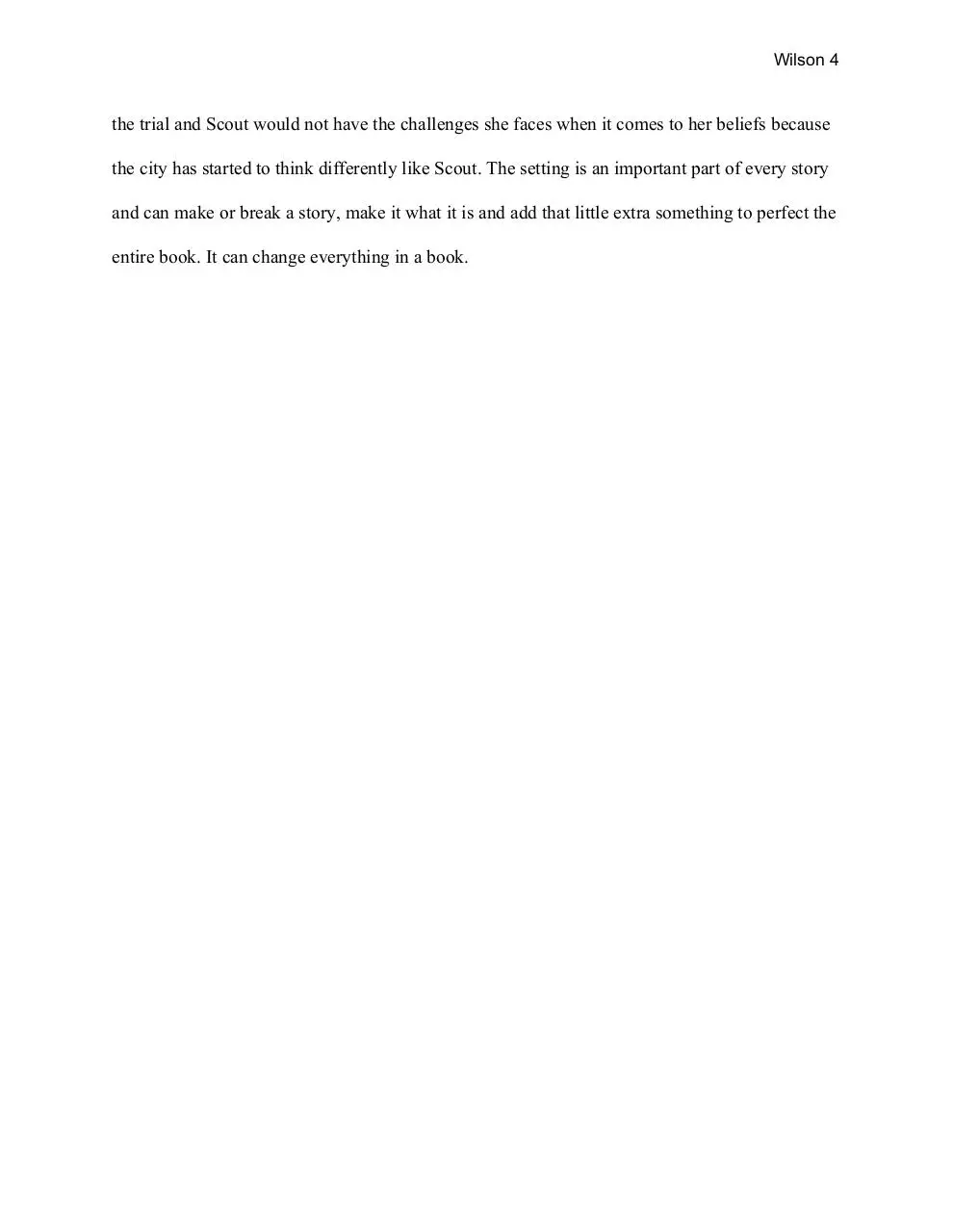TKMB Paper Sydney Wilson (PDF)
File information
This PDF 1.5 document has been generated by / Skia/PDF m67, and has been sent on pdf-archive.com on 06/04/2018 at 21:15, from IP address 96.4.x.x.
The current document download page has been viewed 261 times.
File size: 120.75 KB (5 pages).
Privacy: public file





File preview
Wilson 1
Sydney Wilson
Mrs. Smith
Honors English I
14 April 2016
How the setting affects To Kill a Mockingbird
Where a person lives and what time period they grow up in can greatly affect a person
and how their values are set which can affect their children and how they grow up. Shannon
Alder put it perfectly when she said, “Your perspective on life comes from the cage you were
held captive in” (Alder). One generation can be completely different from the next even if they
are only separated by a few years. Where you grow up is part of you whether you like it or not
and what time period you grew up in can affect a person just as much. Just like how a time
period and place can affect a person, a setting can greatly affect a story, how it unfolds, and the
characters inside it. Harper Lee uses the setting of the post-Civil War rural south to develop Tom
Robinson’s trial, how the mood is set, and how Scout’s values were developed.
The setting affects the trial and verdict of Tom Robinson. People have a way of
classifying others based on the past or their family. Jem explains the process, "There's four kinds
of folks in the world. There's the ordinary kind like us and the neighbors, there's the kind like the
Cunninghams out in the woods, the kind like the Ewells down at the dump, and the Negroes"
(Lee Pg 226). The problem with this way of thinking is that it makes it hard to break away from
a category others have placed a person in and makes people judge a person just by hearing their
name. People never leave Maycomb because they are going through the Great Depression and
there is no money to spare which the author exemplifies in the book: “A day was twenty-four
Wilson 2
hours long but seemed longer. There was no hurry, for there was nowhere to go, nothing to buy
and no money to buy it with, nothing to see outside the boundaries of Maycomb County” (Lee
page 5). People in Maycomb do not know what goes on in other places and just go on believing
what their grandparents believed during the Civil War while the rest of the country is in
reformation. The beliefs that are set in these people’s minds are what caused the verdict to be a
definite guilty.
The setting affects the mood and tone of the story throughout the book. A person can feel
the small town, peaceful, and quiet mood when Scout describes the town in chapter one:
Maycomb was an old town, but it was a tired old town when I first knew it. In rainy
weather the streets turned to red slop. . .somehow it was hotter then. . .bony mules
hitched to Hoover carts flicked flies in the sweltering shade of the live oaks on the
square. Men’s stiff collars wilted by nine in the morning. Ladies bathed before noon,
after their three-o’clock naps, and by nightfall were like soft teacakes with frostings of
sweat and sweet talcum. (Lee)
Maycomb is a small and friendly town and there are normal things that everyone is expected to
do.
The Radleys are considered weird because they do not do the normal things of Maycomb
which is summarized in chapter one:
“The shutters and doors of the Radley house were closed on Sundays, another
thing alien to Maycomb's ways: closed doors meant illness and cold weather only.
Of all days Sunday was the day for formal afternoon visiting: ladies wore corsets,
Wilson 3
men wore coats, children wore shoes. But to climb the Radley front steps and call,
"He-y," of a Sunday afternoon was something their neighbors never did.” (Lee).
The Radley’s are considered weird because they do not do the normal things and this sets the
mood of fear and mystery when it comes to the Radley’s house and Boo.
The setting of a story definitely affects the characters in it. Scout would find her beliefs to
be challenged by traditional beliefs. One example is in Scout’s classroom: " 'Your father does not
know how to teach. You can have a seat now.' I mumbled that I was sorry and retired meditating
upon my crime” (Lee page 17). She thinks being able to read is a good thing and the normal
thing to do, but she is in trouble for doing so and she thinks it is very wrong as shown by her
calling it a crime. Scout is also challenged by her Aunt Alexandra through the book on many
topics. One popular topic is who are considered fine folks, “I never understood her preoccupation
with heredity. Somewhere, I had received the impression that Fine Folks were people who did
the best they could with the sense they had, but Aunt Alexandra was of the opinion, obliquely
expressed that the longer a family had been squatting on one patch of land the finer it was" (Lee
page 130). She thinks differently than her aunt and they clash often especially on this subject of
fine folks. Scout questions her beliefs and values because of the traditional thoughts in this small
town that have no reformation like the bigger places.
A setting can change many aspects of a story like the plot, mood, themes, and characters.
The setting of To Kill a Mockingbird affects Tom Robinson’s trial and its verdict. It also affects
the mood of the book and how Scout’s values are challenged and changed. If the story was in a
big city, the trial would have been no big deal and he might have gotten an innocent verdict since
reformation had taken place in bigger cities. The mood would not be so peaceful and quiet before
Wilson 4
the trial and Scout would not have the challenges she faces when it comes to her beliefs because
the city has started to think differently like Scout. The setting is an important part of every story
and can make or break a story, make it what it is and add that little extra something to perfect the
entire book. It can change everything in a book.
Wilson 5
Works Citied
Lee, Harper. To Kill a Mockingbird. Philadelphia: Lippincott, 1960. Print.
"Popular Quotes." Popular Quotes. Web. 22 Apr. 2016.
Download TKMB Paper - Sydney Wilson
TKMB Paper - Sydney Wilson.pdf (PDF, 120.75 KB)
Download PDF
Share this file on social networks
Link to this page
Permanent link
Use the permanent link to the download page to share your document on Facebook, Twitter, LinkedIn, or directly with a contact by e-Mail, Messenger, Whatsapp, Line..
Short link
Use the short link to share your document on Twitter or by text message (SMS)
HTML Code
Copy the following HTML code to share your document on a Website or Blog
QR Code to this page

This file has been shared publicly by a user of PDF Archive.
Document ID: 0000754066.